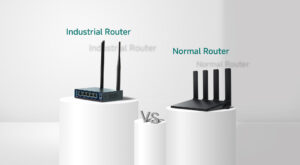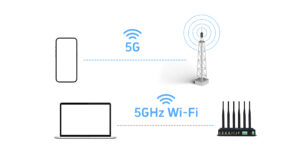When setting up an industrial network, one of the most critical decisions is choosing between fiber optic switches and copper switches. These two types differ fundamentally in their transmission medium, performance, and ideal use cases. Understanding these differences ensures optimal network reliability, speed, and cost-efficiency.
ความแตกต่างหลัก: สื่อการส่งข้อมูล
The most essential distinction lies in how they transmit data. A fiber optic switch uses glass or plastic fibers to carry light signals, much like a “laser flashlight” sending data through an optical cable. These switches typically come with SC, LC, or ST fiber interfaces and require optical modules for operation.
In contrast, a copper switch relies on traditional electrical signals transmitted over copper cables. These switches use standard RJ45 ports (Ethernet jacks), functioning similarly to a “wire” carrying data.
การเปรียบเทียบประสิทธิภาพ
สวิตช์ไฟเบอร์ออปติกมีความโดดเด่นในด้าน การสื่อสารระยะไกลรองรับการส่งสัญญาณโหมดเดียวสูงสุดถึง 120กิโลเมตร และมัลติโหมดสูงสุดถึง 550เมตรขณะที่สวิตช์ทองแดงสูงสุดที่ 100เมตร (with CAT6 cables). Additionally, fiber is completely immune to electromagnetic interference, making it ideal for high-voltage environments like substations. Copper switches, however, require shielded twisted-pair cables to mitigate interference.
In terms of bandwidth, fiber easily supports 1กรัม, 10กรัม, and even 40G speeds, whereas copper switches typically max out at 1G, with 10G being significantly more expensive. Security is another advantage for fiber—since it transmits light, it cannot be tapped without physically cutting the cable. Copper, on the other hand, is vulnerable to electromagnetic eavesdropping.
Latency is also lower with fiber, averaging around 0.1ms, compared to copper’s 0.5ms, which can be crucial for real-time industrial automation.
การเลือกสวิตช์ที่ถูกต้องสำหรับการใช้งานของคุณ
Fiber optic switches are mandatory in environments with strong electromagnetic interference, such as power substations, oil rigs (where explosion-proofing is critical), and railway systems requiring long-distance monitoring. For example, a chemical plant reported zero lightning-induced network failures after switching to fiber.
Copper switches, however, are more practical for short-distance indoor use, temporary production lines (where cost matters), and mobile equipment like AGV carts.
การออกแบบและการพิจารณาต้นทุน
สวิตช์ไฟเบอร์มักมีคุณสมบัติ โมดูลออปติกแบบถอดเปลี่ยนได้ขณะร้อน (SFP/SFP+), พอร์ตไฟเบอร์ป้องกันฝุ่น (ระดับ IP67), และ การตรวจสอบพลังงานแสง เพื่อให้แน่ใจว่าสัญญาณมีความสมบูรณ์ ในขณะเดียวกัน สวิตช์ทองแดงอาจเสนอ การจ่ายพลังงานผ่านอีเทอร์เน็ต (PoE) สำหรับกล้องและจุดเชื่อมต่อไร้สาย ระบบป้องกันไฟกระชาก 6KV, และ พอร์ต 10/100/1000M ที่เจรจาอัตโนมัติ.
ในด้านต้นทุน สวิตช์ไฟเบอร์อุตสาหกรรม โดยทั่วไปแล้ว แพงกว่า มากกว่าสายทองแดง ซึ่งส่วนใหญ่เป็นผลมาจากต้นทุนเพิ่มเติมของโมดูลออปติก อย่างไรก็ตาม ช่องว่างด้านราคาจะแคบลงเมื่อพิจารณาถึงความน่าเชื่อถือในระยะยาวและการบำรุงรักษาที่ลดลงในสภาพแวดล้อมที่รุนแรง อุปกรณ์ระดับอุตสาหกรรมโดยทั่วไปจะมีราคา มากขึ้นอย่างมีนัยสำคัญ มากกว่าผลิตภัณฑ์เทียบเท่าเชิงพาณิชย์เนื่องจากมีการออกแบบที่แข็งแกร่งและทนทานยิ่งขึ้น
คำแนะนำขั้นสุดท้าย
สำหรับ ความต้องการระยะไกล การรบกวนสูง หรือความปลอดภัยสูงสวิตช์ไฟเบอร์ออปติกเป็นตัวเลือกที่ดีที่สุด แม้จะมีต้นทุนที่สูงกว่าก็ตาม การใช้งานระยะสั้น เคลื่อนที่ หรือคำนึงถึงงบประมาณ, copper switches are more practical. The most efficient hybrid approach uses fiber for backbone connections and copper for endpoint devices.
แนวโน้มใหม่ที่กำลังเกิดขึ้นคือ สวิตช์ไฮบริดสำหรับอุตสาหกรรม (เหมือนอย่างบางคน นางแบบดาวรุ่ง) ที่บูรณาการทั้งพอร์ตไฟเบอร์และทองแดง เพื่อเพิ่มความยืดหยุ่นมากขึ้น
By carefully evaluating these factors, businesses can build industrial networks that balance performance, reliability, and cost-effectiveness.


